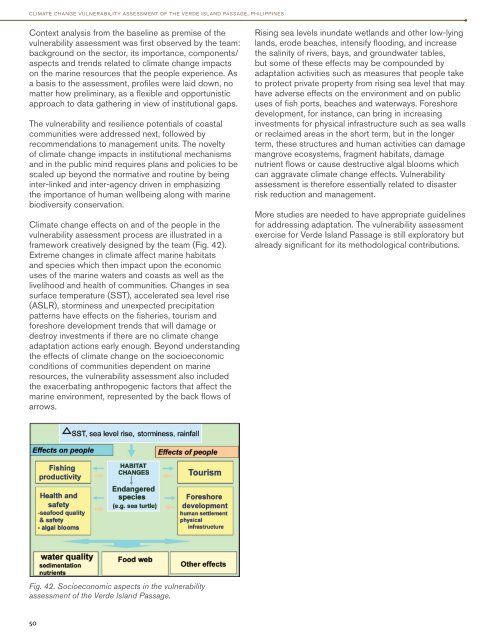of the Verde Island Passage, Philippines - weADAPT
of the Verde Island Passage, Philippines - weADAPT
of the Verde Island Passage, Philippines - weADAPT
You also want an ePaper? Increase the reach of your titles
YUMPU automatically turns print PDFs into web optimized ePapers that Google loves.
climate change vulnerability assessment <strong>of</strong> <strong>the</strong> verde island passage, philippines<br />
Context analysis from <strong>the</strong> baseline as premise <strong>of</strong> <strong>the</strong><br />
vulnerability assessment was first observed by <strong>the</strong> team:<br />
background on <strong>the</strong> sector, its importance, components/<br />
aspects and trends related to climate change impacts<br />
on <strong>the</strong> marine resources that <strong>the</strong> people experience. As<br />
a basis to <strong>the</strong> assessment, pr<strong>of</strong>iles were laid down, no<br />
matter how preliminary, as a flexible and opportunistic<br />
approach to data ga<strong>the</strong>ring in view <strong>of</strong> institutional gaps.<br />
The vulnerability and resilience potentials <strong>of</strong> coastal<br />
communities were addressed next, followed by<br />
recommendations to management units. The novelty<br />
<strong>of</strong> climate change impacts in institutional mechanisms<br />
and in <strong>the</strong> public mind requires plans and policies to be<br />
scaled up beyond <strong>the</strong> normative and routine by being<br />
inter-linked and inter-agency driven in emphasizing<br />
<strong>the</strong> importance <strong>of</strong> human wellbeing along with marine<br />
biodiversity conservation.<br />
Climate change effects on and <strong>of</strong> <strong>the</strong> people in <strong>the</strong><br />
vulnerability assessment process are illustrated in a<br />
framework creatively designed by <strong>the</strong> team (Fig. 42).<br />
Extreme changes in climate affect marine habitats<br />
and species which <strong>the</strong>n impact upon <strong>the</strong> economic<br />
uses <strong>of</strong> <strong>the</strong> marine waters and coasts as well as <strong>the</strong><br />
livelihood and health <strong>of</strong> communities. Changes in sea<br />
surface temperature (SST), accelerated sea level rise<br />
(ASLR), storminess and unexpected precipitation<br />
patterns have effects on <strong>the</strong> fisheries, tourism and<br />
foreshore development trends that will damage or<br />
destroy investments if <strong>the</strong>re are no climate change<br />
adaptation actions early enough. Beyond understanding<br />
<strong>the</strong> effects <strong>of</strong> climate change on <strong>the</strong> socioeconomic<br />
conditions <strong>of</strong> communities dependent on marine<br />
resources, <strong>the</strong> vulnerability assessment also included<br />
<strong>the</strong> exacerbating anthropogenic factors that affect <strong>the</strong><br />
marine environment, represented by <strong>the</strong> back flows <strong>of</strong><br />
arrows.<br />
Rising sea levels inundate wetlands and o<strong>the</strong>r low-lying<br />
lands, erode beaches, intensify flooding, and increase<br />
<strong>the</strong> salinity <strong>of</strong> rivers, bays, and groundwater tables,<br />
but some <strong>of</strong> <strong>the</strong>se effects may be compounded by<br />
adaptation activities such as measures that people take<br />
to protect private property from rising sea level that may<br />
have adverse effects on <strong>the</strong> environment and on public<br />
uses <strong>of</strong> fish ports, beaches and waterways. Foreshore<br />
development, for instance, can bring in increasing<br />
investments for physical infrastructure such as sea walls<br />
or reclaimed areas in <strong>the</strong> short term, but in <strong>the</strong> longer<br />
term, <strong>the</strong>se structures and human activities can damage<br />
mangrove ecosystems, fragment habitats, damage<br />
nutrient flows or cause destructive algal blooms which<br />
can aggravate climate change effects. Vulnerability<br />
assessment is <strong>the</strong>refore essentially related to disaster<br />
risk reduction and management.<br />
More studies are needed to have appropriate guidelines<br />
for addressing adaptation. The vulnerability assessment<br />
exercise for <strong>Verde</strong> <strong>Island</strong> <strong>Passage</strong> is still exploratory but<br />
already significant for its methodological contributions.<br />
Fig. 42. Socioeconomic aspects in <strong>the</strong> vulnerability<br />
assessment <strong>of</strong> <strong>the</strong> <strong>Verde</strong> <strong>Island</strong> <strong>Passage</strong>.<br />
50
















